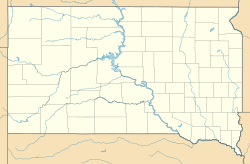Flatiron, South Dakota facts for kids
Quick facts for kids
Flatiron, South Dakota
Yellow Creek
|
|
|---|---|
| Country | United States |
| State | South Dakota |
| County | Lawrence County |
| Elevation | 5,436 ft (1,657 m) |
| Time zone | UTC-7 (MST) |
| • Summer (DST) | UTC-6 (MDT) |
Flatiron, once called Yellow Creek or Flat Iron City, is a ghost town in Lawrence County, South Dakota, United States. It was famous for its very successful gold mining operations.
Contents
History of Flatiron
How Flatiron Began
As many people started to move into the Black Hills during the Black Hills Gold Rush, small cabins began to appear around Yellow Creek. In 1894, people started to plan out the town. However, it wasn't fully built yet.
By May 1896, the area became very busy. Many large buildings and small cabins were built, including a two-story boarding house. Flatiron was first advertised as Flat Iron City on a big sign. There were also freshwater springs nearby, and a well was dug for water. Over time, the town was called Yellow Creek, and then finally Flatiron.
Gold Mining Operations
The Chicago, Burlington & Quincy Railroad ran right through Flatiron. The town was home to the Wasp No. 2 Mine, which started in the 1890s. This was an open-pit mine, meaning it dug gold from the surface. It was well-known for its gold.
At first, mining was slow. But then, a new manager named John Gray took over. He helped the mine use explosives to dig deeper and break up the ore (rock containing gold). They would break up about 5,000 to 6,000 tons of ore at a time. This used around 1,000 pounds (450 kg) of powder. The gold ore found here was "low-grade," meaning it didn't have a lot of gold in each rock. However, there were huge amounts of it.
The ore was moved from the mine using the company's own railroad. It was then pushed through a special mill using gravity. This mill used a chemical process called cyanide to get the gold out. The gold ore sold for US$1.6 a ton, which was a big achievement back then. The Little Blue Mine, located north of Flatiron, also became very successful. It produced gold and a material called flux, which is used in metalworking.
The main railroad line was later extended to the mill. However, the slope was so steep that train cars had to be pulled up by a winch (a machine that pulls with a rope or cable). Two different railroad lines ran through the town. One started and ended in Flatiron, while the other led into the town. The very fine leftover rock from the mining, called tailings, was used as fill and ballast (material that supports railroad tracks). It was like sand.
Growth and Becoming a Ghost Town
The town grew and became successful because of the mine. Soon after it was founded, Flatiron had about a dozen homes. By 1915, it had around 30 buildings. These included a school, several large mills, many stores, and a post office. The leftover mining tailings covered one side of a large valley nearby.
In 1927, heavy rain caused a powerful flood. This flood made the piled-up tailings slide down. The railroad tracks, a train, and its engine were buried under several feet of sand. Sadly, the engineer was killed. The tracks were not uncovered until around 1974. At that time, Lead and Deadwood, two nearby towns, started using the tailings to sand icy roads in winter.
Eventually, the mines closed down. Because of this, the town became completely empty. More than 80% of Flatiron has sunk into the old mine tunnels below. What's left are mostly just building foundations.
Geography of Flatiron
Flatiron is located in the Black Hills area of east-central Lawrence County. It is about two miles (3.2 km) south of Lead. The town itself was built on the side of a hill and near a large valley. To the north of Flatiron is the abandoned Little Blue Mine.


